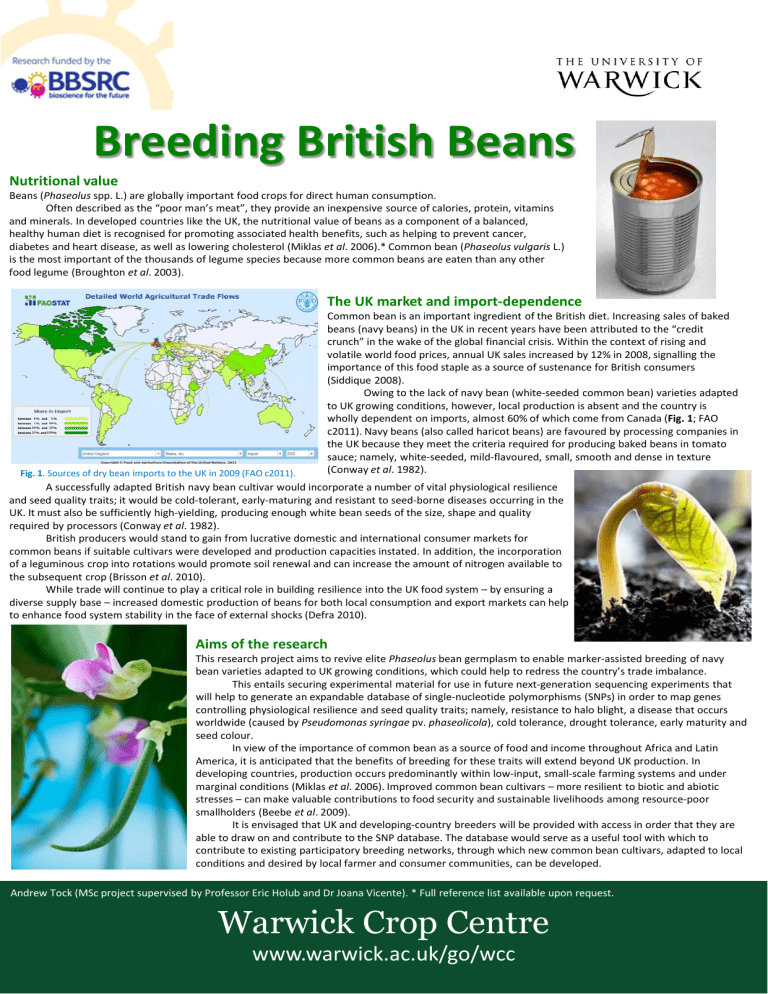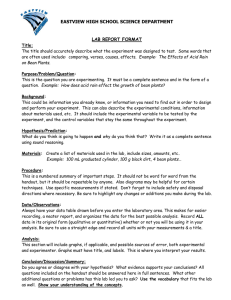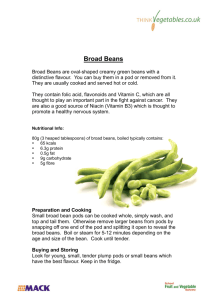Breeding British Beans Nutritional value

Breeding British Beans
Nutritional value
Beans (Phaseolus spp. L.) are globally important food crops for direct human consumption.
Often described as the “poor man’s meat”, they provide an inexpensive source of calories, protein, vitamins and minerals. In developed countries like the UK, the nutritional value of beans as a component of a balanced, healthy human diet is recognised for promoting associated health benefits, such as helping to prevent cancer, diabetes and heart disease, as well as lowering cholesterol (Miklas et al. 2006).* Common bean (Phaseolus vulgaris L.) is the most important of the thousands of legume species because more common beans are eaten than any other food legume (Broughton et al. 2003).
The UK market and import-dependence
Common bean is an important ingredient of the British diet. Increasing sales of baked beans (navy beans) in the UK in recent years have been attributed to the “credit crunch” in the wake of the global financial crisis. Within the context of rising and volatile world food prices, annual UK sales increased by 12% in 2008, signalling the importance of this food staple as a source of sustenance for British consumers
(Siddique 2008).
Owing to the lack of navy bean (white-seeded common bean) varieties adapted to UK growing conditions, however, local production is absent and the country is wholly dependent on imports, almost 60% of which come from Canada (Fig. 1; FAO c2011). Navy beans (also called haricot beans) are favoured by processing companies in the UK because they meet the criteria required for producing baked beans in tomato sauce; namely, white-seeded, mild-flavoured, small, smooth and dense in texture
(Conway et al. 1982).
Fig. 1. Sources of dry bean imports to the UK in 2009 (FAO c2011).
A successfully adapted British navy bean cultivar would incorporate a number of vital physiological resilience and seed quality traits; it would be cold-tolerant, early-maturing and resistant to seed-borne diseases occurring in the
UK. It must also be sufficiently high-yielding, producing enough white bean seeds of the size, shape and quality required by processors (Conway et al. 1982).
British producers would stand to gain from lucrative domestic and international consumer markets for common beans if suitable cultivars were developed and production capacities instated. In addition, the incorporation of a leguminous crop into rotations would promote soil renewal and can increase the amount of nitrogen available to the subsequent crop (Brisson et al. 2010).
While trade will continue to play a critical role in building resilience into the UK food system – by ensuring a diverse supply base – increased domestic production of beans for both local consumption and export markets can help to enhance food system stability in the face of external shocks (Defra 2010).
Aims of the research
This research project aims to revive elite Phaseolus bean germplasm to enable marker-assisted breeding of navy bean varieties adapted to UK growing conditions, which could help to redress the country’s trade imbalance.
This entails securing experimental material for use in future next-generation sequencing experiments that will help to generate an expandable database of single-nucleotide polymorphisms (SNPs) in order to map genes controlling physiological resilience and seed quality traits; namely, resistance to halo blight, a disease that occurs worldwide (caused by Pseudomonas syringae pv. phaseolicola), cold tolerance, drought tolerance, early maturity and seed colour.
In view of the importance of common bean as a source of food and income throughout Africa and Latin
America, it is anticipated that the benefits of breeding for these traits will extend beyond UK production. In developing countries, production occurs predominantly within low-input, small-scale farming systems and under marginal conditions (Miklas et al. 2006). Improved common bean cultivars – more resilient to biotic and abiotic stresses – can make valuable contributions to food security and sustainable livelihoods among resource-poor smallholders (Beebe et al. 2009).
It is envisaged that UK and developing-country breeders will be provided with access in order that they are able to draw on and contribute to the SNP database. The database would serve as a useful tool with which to contribute to existing participatory breeding networks, through which new common bean cultivars, adapted to local conditions and desired by local farmer and consumer communities, can be developed.
Andrew Tock (MSc project supervised by Professor Eric Holub and Dr Joana Vicente). * Full reference list available upon request.






